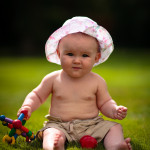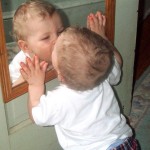Baby Play
Playing with your baby is one of the most important things you can do for them – it’s good for your baby, good for you, and good for your relationship! The best time to play with your baby is when they’re well fed and rested, with a clean nappy. Watch out for times when your baby is looking around them, and seems settled and relaxed. This is the best time to play. If your baby sometimes doesn’t seem interested in playing with you, don’t worry, this is normal, and just means their system is focussed on other things at that moment. Don’t be offended, come back and try again later when your baby’s brain is ready to take in the fun signals! Watch this video to find out more:
Thanks to the Getting to Know Your Baby project for letting us include this video. Copyright owned by NSPCC and Warwick Medical School: www.your-baby.org.uk
In the early months after birth, the best way to play with your baby is by talking and interacting face to face, have a look below for some ideas.
Around 4-5 months babies get more interested in objects and toys than in faces. This occurs as they learn to use their hands better, so they become fascinated by grasping and hitting things, and exploring the world around them.
It’s normal for them to look at people less than they used to, as they aren’t able to combine their attention to objects and to people at the same time.
Parents can help the baby to learn how to combine their attention as they get close to the end of the first year of life. They can do this by tuning in to what the baby is focussed on, joining in with them, and guessing what they might want or be trying to do.
When babies play with toys, they are constantly learning about the world around them. It helps their physical development and coordination, their vision, their mental development.
The toys don’t have to be expensive – babies often love cardboard boxes, the cardboard tube from a toilet roll, light pots and pans from the kitchen and a wooden spoon – anything that they can’t injure themselves with! Active play where babies hold and move things is great, and much better than passive activities like watching TV.
Playing with your baby, and supporting them to play themselves, is never a waste of your time. It is one of the most valuable things that you can give to them, better than any expensive pram or clothes or than having a really clean house!
Here is a short video about how babies play:
Thanks to the Getting to Know Your Baby project for letting us include this video. Copyright owned by NSPCC and Warwick Medical School: www.your-baby.org.uk
 Newborns
Newborns
 One of the best kinds of play you can do with a newborn is having conversations with them. Spend lots of time looking in to their eyes and making big expressions with your face, like big smiles and surprised faces.
One of the best kinds of play you can do with a newborn is having conversations with them. Spend lots of time looking in to their eyes and making big expressions with your face, like big smiles and surprised faces.
Talk to them gently. Watch what they do in return, whether they copy your face, or try to answer you. Imagine what they might be saying back to you if they could talk.
They might need to look away for a while as this kind of contact can be very intense for babies, so if they do just wait patiently until they are ready to engage again.
Around 2 months, your baby will also start to smile at you when you play and talk together. What does your baby’s smile tell you about what they are feeling?
 Newborns also love bold patterns, like black and white stripes, or clothes with bold patterns. Hold these near your baby’s face and move them slowly, allowing your baby to watch them.
Newborns also love bold patterns, like black and white stripes, or clothes with bold patterns. Hold these near your baby’s face and move them slowly, allowing your baby to watch them.
Things with bold colours can also be attractive to babies. Wear a stripy t-shirt or scarf with a bold pattern, and hold your baby so they can look at it from your knee.
Blowing bubbles that your baby can watch floating by can also be fun. Think about what these patterns make your baby think and feel. These activities are good for developing your baby’s sight.
 Newborns are really interested in noises too. Make funny sounds with your mouth, like rolling or clicking your tongue, vibrating your lips, making ‘pop’ noises or ‘mamamama’ sounds.
Newborns are really interested in noises too. Make funny sounds with your mouth, like rolling or clicking your tongue, vibrating your lips, making ‘pop’ noises or ‘mamamama’ sounds.
If you have any toys that squeak or jingle or make a noise, try these out gently, watch to see if your baby likes them, and continue if they do.
Things from around the house work too, like scrunched up paper or plastic. What kind of face does your baby make when they hear different sounds? Puzzled? Interested?
 Newborns have really sensitive skin. Gently rub them with your hands, or ask your health visitor to show you some baby massage techniques.
Newborns have really sensitive skin. Gently rub them with your hands, or ask your health visitor to show you some baby massage techniques.
Baby massage has been shown to help babies to sleep and to learn. You can also try rubbing your baby with soft materials, like a sponge, a soft make-up brush, a soft pullover. They will love the different feelings on their body. Watch their reaction to see which textures they prefer.
Singing to your baby at any age is a great way to connect with them, to help to soothe them or to play with them. You don’t have to be a really great singer, your many will love listening to your voice and the rhythm of the song. Here’s a short video about singing to your baby:
Thanks to the Getting to Know Your Baby project for letting us include this video. Copyright owned by NSPCC and Warwick Medical School: www.your-baby.org.uk
 3-6 Months
3-6 Months
Keep up the conversations, as your baby at this age will be starting to chat more with you. They will also smile more often at you, and try to speak back to you. They will be practising their letter sounds, (like goo-goo) which is great for learning language. What do you think they could be trying to say?
 From around 4 to 5 months of age, babies start to get better at using their hands, and they become really interested in objects—hitting, holding, dropping and picking up—fascinates them!
From around 4 to 5 months of age, babies start to get better at using their hands, and they become really interested in objects—hitting, holding, dropping and picking up—fascinates them!
Babies are not yet able to combine their attention to people and objects at the same time so it’s normal for them to look at your face less often than in the first four months.
You can help your baby to learn to combine their attention by watching what they are interested in, joining in with them, and guessing what they might be thinking or trying to do as they play.
It won’t be until around the first birthday that they can combine attention properly, but the more practice they get the better!
 Babies this age love colourful things and especially moving colourful things. In the summer, it’s fun to sit with your baby under a tree so they can watch the light moving through the leaves overhead.
Babies this age love colourful things and especially moving colourful things. In the summer, it’s fun to sit with your baby under a tree so they can watch the light moving through the leaves overhead.
Show them a fish tank or a birdcage if you’re passing a pet shop, where they can watch the brightly coloured fish and birds darting around. Watch their expression – what are they thinking? What captures their attention?
Just as lots of mums enjoy a massage, babies really like a gentle rub on their bodies. Before or after their bath, you can try rubbing their limbs gently with some baby lotion, while chatting or singing. Watch their reaction to see which parts they really enjoy, or which parts are too ticklish!
 Your baby is never too young to have stories read to them. Even before they are born this can be a nice soothing activity.
Your baby is never too young to have stories read to them. Even before they are born this can be a nice soothing activity.
When you read the story, take it slowly and let your baby see the pictures. Do funny voices as you read to keep the story interesting. Watch to see what your baby pays attention to or which pages they particularly enjoy.
Your baby might start to enjoy peek-a-boo from this point on. This can be fun to try just after changing your baby. Hold up a towel or blanket to cover your face, then pull it down and say ‘peek-a-boo’ with a surprised face! Do this nice and gently as some babies are frightened by it at first. Read your baby’s reaction and if you decide that they enjoy it, carry on!
 You can also dangle bright toys over your baby when they are lying on their backs. This doesn’t have to be an expensive toy, sometimes the ends of a scarf, or a colourful necklace you’re wearing can be really fascinating for the baby to watch. Watch which objects they prefer.
You can also dangle bright toys over your baby when they are lying on their backs. This doesn’t have to be an expensive toy, sometimes the ends of a scarf, or a colourful necklace you’re wearing can be really fascinating for the baby to watch. Watch which objects they prefer.
 Babies this age start to get interested in their reflection in the mirror. When you’re holding your baby and passing the mirror, stop for a few moments to point out their reflection.
Babies this age start to get interested in their reflection in the mirror. When you’re holding your baby and passing the mirror, stop for a few moments to point out their reflection.
Stand close to the mirror so your baby can see their reflection. Make funny faces and see if your baby notices. Does he realise it’s your reflection?
 7-9 Months
7-9 Months
 Babies often enjoy the feeling of being lifted in the air. When you’re relaxing with your baby, lift them over you so they’re horizontal and feel like they’re flying. Make an airplane noise to make this extra fun.
Babies often enjoy the feeling of being lifted in the air. When you’re relaxing with your baby, lift them over you so they’re horizontal and feel like they’re flying. Make an airplane noise to make this extra fun.
Watch your baby’s expression to see what they think of it.
 If your baby doesn’t make enough noise as it is, you can try drumming with them!
If your baby doesn’t make enough noise as it is, you can try drumming with them!
Sit together, each with a stick or a wooden spoon, and something to bang it on, like a light pot or container. Bang the drums and sing a nursery rhyme or a pop song to your baby. Notice which songs they particularly like.
Or maybe your baby likes rap, R&B or dance music! This can depend on what music they heard you playing when you were pregnant. This is a fun way to find out what sounds your baby prefers.
 Another fun game to play is ‘horsey-horsey’.
Another fun game to play is ‘horsey-horsey’.
Holding your baby on your knee jiggle them gently up and down while singing a rhyme, like “horsey horsey don’t you stop, just let your feet go clippity clop, let your tail go swish and your feet go round, giddy up we’re homeward bound” and on the last word, open your knees while holding your baby carefully, so their bum falls down a little bit (but don’t let them fall down!).
You can try any rhyme or song you like for this. Watch your baby’s reaction – are they surprised? Do they enjoy it?
If they do you can go again and pause just before the last word to see if they are expecting the drop. This can get great laughs out of your baby!
 Babies love repetition, they like when you do the same action over and over, and they often like to do the same action a lot too, like throwing something on the floor.
Babies love repetition, they like when you do the same action over and over, and they often like to do the same action a lot too, like throwing something on the floor.
This can get pretty boring for grown-ups, but it’s really good for the baby’s learning! Try to be patient by focussing on your baby’s experience – what are they enjoying about the game? What could it be teaching them? How does it make them feel?
 A great repetitive game is ‘round and round the garden’, where you make circles on your baby’s hand, saying ‘round and round the garden, like a teddy bear’.
A great repetitive game is ‘round and round the garden’, where you make circles on your baby’s hand, saying ‘round and round the garden, like a teddy bear’.
As you sing ‘one step, two step’, move your fingers up your baby’s arm, and then say ‘tickly under there’ as you tickle under their arm.
This can be really fun to play, and it’s nice to leave a pause before you tickle to create more expectation.
 Remember to keep up the reading at every age.
Remember to keep up the reading at every age.
It’s a nice opportunity to cuddle up close together, and the books provide lots of stimulation for your baby’s vision and for their movement as they learn to turn the pages. It’s also great for learning words.
As you read, notice which pages and which words they seem to like. Which book is their favourite?
 10-12 Months
10-12 Months
 Your baby’s understanding of objects will be developing, and you can help them along with some play with toys.
Your baby’s understanding of objects will be developing, and you can help them along with some play with toys.
With two plastic beakers, one each, experiment with putting different things in, and pouring them out again. You can try water, if it’s in the bath. You can try sand if you’re on the beach or in the garden. Or you can try any kinds of blocks or dolls if you’re indoors.
Rattle the beaker when it is full, and then pour it out making a funny noise. Help your baby to pour things from one cup to the other.
Which game is their favourite? Do they like doing this alone or with your help?
 You don’t need to buy an expensive play house – most babies love playing in a cardboard box!
You don’t need to buy an expensive play house – most babies love playing in a cardboard box!
When you have a box at home, make sure there are no staples in it, and then sit it on its side so your baby can crawl in and out. Stay with them and play peekaboo by hiding your face when they go inside and then popping out to say hello. You can pretend it’s a house, or a car, and make funny driving noises.
Watch to see if they like these games. What do you think they are thinking when they go in the box? Do they know that you’re pretending?

Babies this age love putting things in containers and taking them out again.
Putting blocks or toys in to a cardboard box and spilling them out again can be really fun for the baby to play, and believe it or not it can help a baby to learn!
As you play this game with them, watch how they concentrate on what they are doing.
At all these ages babies love rhymes, songs and rhythms. Any game you’re playing can be made better by adding a silly rhyme or phrase that you repeat, like ‘up, up, up and away!’ when you’re playing airplane. Or ‘in we go’ and ‘weeeeee out they fall’ when pouring things out of containers.
This creates a sense of fun for your baby and the repetition also helps with learning language. See what best captures your baby’s attention as you play together.
